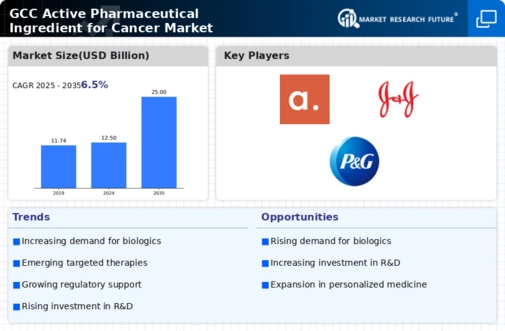Rising Cancer Incidence
The increasing prevalence of cancer globally is a primary driver for the Global GCC Active Pharmaceutical Ingredient for Cancer Market Industry. As cancer cases rise, the demand for effective treatment options intensifies. In 2024, the market is projected to reach 12.5 USD Billion, reflecting the urgent need for innovative therapies. The World Health Organization indicates that cancer is one of the leading causes of morbidity and mortality worldwide, necessitating a robust supply of active pharmaceutical ingredients. This trend is likely to continue, with projections suggesting that the market could expand significantly, potentially reaching 25 USD Billion by 2035.
Growing Generic Drug Market
The expansion of the generic drug market is a crucial factor propelling the Global GCC Active Pharmaceutical Ingredient for Cancer Market Industry. As patents for several cancer medications expire, generic alternatives are becoming more accessible and affordable. This shift not only increases the availability of essential active pharmaceutical ingredients but also enhances competition among manufacturers, leading to lower prices for consumers. The rise of generics is expected to contribute to the market's growth, with a projected increase in value from 12.5 USD Billion in 2024 to 25 USD Billion by 2035, reflecting the ongoing demand for cost-effective cancer treatments.
Advancements in Biotechnology
Technological advancements in biotechnology are reshaping the Global GCC Active Pharmaceutical Ingredient for Cancer Market Industry. Innovations such as monoclonal antibodies and personalized medicine are enhancing treatment efficacy and patient outcomes. These advancements facilitate the development of novel active pharmaceutical ingredients that target specific cancer pathways, thereby improving therapeutic effectiveness. As a result, the market is experiencing a notable growth trajectory, with a compound annual growth rate of 6.5% anticipated from 2025 to 2035. This growth underscores the importance of continuous investment in research and development to harness biotechnological innovations for cancer treatment.
Government Initiatives and Funding
Government initiatives aimed at combating cancer are significantly influencing the Global GCC Active Pharmaceutical Ingredient for Cancer Market Industry. Various countries are increasing funding for cancer research and treatment programs, thereby enhancing the availability of active pharmaceutical ingredients. For instance, national health policies are being revised to prioritize cancer care, which includes the development and distribution of essential medications. This increased governmental support is expected to drive market growth, contributing to the projected market value of 12.5 USD Billion in 2024 and potentially doubling to 25 USD Billion by 2035.
Emerging Markets and Increased Access
Emerging markets are playing an increasingly vital role in the Global GCC Active Pharmaceutical Ingredient for Cancer Market Industry. Countries in the GCC region are witnessing improvements in healthcare infrastructure and increased access to cancer treatments. This expansion is driven by rising disposable incomes and a growing awareness of cancer prevention and treatment options. As these markets develop, the demand for active pharmaceutical ingredients is expected to surge, contributing to the overall market growth. The anticipated compound annual growth rate of 6.5% from 2025 to 2035 highlights the potential for significant market expansion in these regions.














Leave a Comment